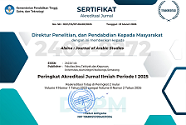Analisis Kesesuaian Kompetensi Dasar dengan Bahan Ajar Bahasa Arab MTs Kelas IX Karya Yushi M. Mahmudah
DOI:
https://doi.org/10.21580/alsina.3.1.10432Keywords:
Analysis of Teaching Materials, Content Analysis, Basic Competencies, Curriculum 2013Abstract
The Indonesian Ministry of Religion has published Arabic textbooks for ninth grade to assist the implementation of the revision of the Core and Basic Competencies. The purpose of this research is to evaluate the compatibility of Arabic teaching materials with the Basic Competencies outlined in KMA No. 183 of 2019. The study employs a library research design with the data collected using documentation. The sample was selected using purposive sampling techniques, namely the content examination and assessment. Content analysis was performed to analyze the data. The results showed that some contents of the textbook did not comply with the requirements of the basic competence. Several readings and conversational texts did not instance of grammatical structures in use. The textbook did not contain practice questions for mahrah istima'. Also, only 13 (out of 34) questions in the mahārah istimā' segment pertain to higher-order thinking skills (HOTS), while the majority of the questions in mahārah kalām and kitābah pertains to the basic competence of 2013 Curriculum.
Downloads
References
Ahqaf, Muhammad Infithar Al. “Analisis Kelayakan Bahan Ajar Bahasa Arab Untuk Madrasah Tsanawiyah.” Jurnal Al-Maqayis 6, no. 2 (2019): 1–12. https://doi.org/10.18592/JAMS.V6I2.5450.
Ainin, Moh. “Penilaian Dalam Pembelajaran Bahasa Arab di Madrasah atau Sekolah: HOTS, MOTS atau LOTS?” In Prosiding Konferensi Nasional Bahasa Arab (KONASBARA), 155–65. Malang: Universitas Negeri Malang, 2018. http://prosiding.arab-um.com/index.php/konasbara/article/view/266.
Albantani, Azkia Muharom. “Implementasi Kurikulum 2013 pada Pembelajaran Bahasa Arab di Madrasah Ibtidaiyah.” Arabiyat: Jurnal Pendidikan Bahasa Arab dan Kebahasaaraban 2, no. 2 (December 2015): 178–91. https://doi.org/10.15408/a.v2i2.2127.
Anderson, Lorin W., David R. Krathwohl, Peter W. Airasian, Kathleen A. Cruikshank, Richard E. Mayer, Paul R. Pintrich, James Raths, and Merlin C. Wittrock. A Taxonomy for Learning, Teaching, and Assessing: A Revision of Bloom’s Taxonomy of Educational Objectives. New York: Longman, 2001.
Azhari, Afifa Wijdan. “Analisis Buku Ajar Bahasa Arab Kelas VI Madrasah Ibtidaiah Terbitan Karya Toha Putra.” ALSUNIYAT: Jurnal Penelitian Bahasa, Sastra, dan Budaya Arab 1, no. 2 (2018): 125–36. https://doi.org/10.17509/alsuniyat.v1i2.24360.
Di, Wu, Xing Danxia, and Lu Chun. “The Effects of Learner Factors on Higher-Order Thinking in the Smart Classroom Environment.” Journal of Computers in Education 6, no. 4 (2019): 483–98. https://doi.org/10.1007/s40692-019-00146-4.
Faoziyah, Laila. “Analisis Buku Ajar Bahasa Arab Madrasah Aliyah Berdasarkan Kurikulum 2013.” Institut Agama Islam Negeri Purwokerto, 2020.
Ghanizadeh, Afsaneh, Ali H. Al-Hoorie, and Safoura Jahedizadeh. “Higher Order Thinking Skills.” In Higher Order Thinking Skills in the Language Classroom: A Concise Guide, edited by Afsaneh Ghanizadeh, Ali H. Al-Hoorie, and Safoura Jahedizadeh, 1–51. Second Language Learning and Teaching. Cham: Springer, 2020. https://doi.org/10.1007/978-3-030-56711-8_1.
Kementerian Agama. Keputusan Menteri Agama Tentang Kurikulum PAI dan Bahasa Arab pada Madrasah, Pub. L. No. 183, 1 (2019).
———. Keputusan Menteri Agama tentang Pedoman Implementasi Kurikulum pada Madrasah, Pub. L. No. 184 (2019).
Kwangmuang, Parama, Suwisa Jarutkamolpong, Watcharee Sangboonraung, and Srisuda Daungtod. “The Development of Learning Innovation to Enhance Higher Order Thinking Skills for Students in Thailand Junior High Schools.” Heliyon 7, no. 6 (June 2021): 1–13. https://doi.org/10.1016/J.HELIYON.2021.E07309.
Laksana, Priyo Dwi Hendra, Toto’ Bara Setiawan, and Susi Setiawani. “Proses Berpikir Siswa yang Mengikuti Ekstrakurikuler Bridge pada Penyelesaian Soal Cerita Teori Peluang Berdasarkan Ranah Kognitif Taksonomi Bloom Revisi.” KadikmA 8, no. 1 (2017): 172–82. https://doi.org/10.19184/kdma.v8i1.5279.
Lubis, Maesaroh, and Nani Widiawati. “Integrasi Domain Afektif Taksonomi Bloom Dengan Pendidikan Spiritual Al-Ghazali (Telaah Kitab Ayyuhal Walad).” JURNAL EDUCATIVE: Journal of Educational Studies 5, no. 1 (2020): 41–56. https://doi.org/10.30983/educative.v5i1.3228.
Mabrurrosi, Mabrurrosi. “Analisis Buku Ajar Bahasa Arab Karya Dr. D. Hidayat.” Al-Irfan: Journal of Arabic Literature and Islamic Studies 3, no. 2 (September 10, 2020): 237–57. https://doi.org/10.36835/al-irfan.v3i2.4016.
Mahmudah, Yushi M. Bahasa Arab MTs Kelas IX. Jakarta: Direktorat KSKK Madrasah, Direktorat Jenderal Pendidikan Islam, 2020.
Mulyasa, E. Pengembangan Dan Imlementasi Kurikulum 2013. Bandung: PT Remaja Rosdakarya, 2014.
Prameswari, Laudria Nanda. “Analisis Kemampuan Baca Tulis Al-Qur’an Siswa MTs Dalam Perspektif Taksonomi Bloom.” Edudeena 3, no. 2 (2019): 69–78.
Rahmawati, Nailur. “Pembelajaran Bahasa Arab: Menuju Higher Order Thinking Skills (HOTS).” In Prosiding Konferensi Nasional Bahasa Arab (KONASBARA), 149–54. Malang: Universitas Negeri Malang, 2018. http://prosiding.arab-um.com/index.php/konasbara/article/view/265.
Rahmi Nur Fauziah, Indah, Syihabudin Syihabudin, and Asep Sopian. “Analisis Kualitas Tes Bahasa Arab Berbasis Higher Order Thinking Skill (HOTS).” LISANUNA: Jurnal Ilmu Bahasa Arab dan Pembelajarannya 10, no. 1 (August 2020): 45–54. https://doi.org/10.22373/ls.v10i1.7805.
Ramah, Sutri, and Miftahur Rohman. “Analisis Buku Ajar Bahasa Arab Madrasah Aliyah Kurikulum 2013.” Arabiyatuna: Jurnal Bahasa Arab 2, no. 2 (2018): 141–60. https://doi.org/10.29240/jba.v2i2.552.
Setyawan, Cahya Edi, Luthfi Abdul Basit, and Muhamad Fathoni. “Telaah Bahan Ajar Bahasa Arab ‘Ayo Fasih Berbahasa Arab’ Madrasah Aliyah Kelas XII Karya Hasan Saefullah (Tinjauan Materi Berdasarkan Teori Mackey).” In Prosiding Konferensi Nasional Bahasa Arab (KONASBARA), 225–34. Malang: Universitas Negeri Malang, 2018. http://prosiding.arab-um.com/index.php/konasbara/article/view/273.
Wachdah, Riham Lailatul. “Evaluasi Buku Ajar Bahasa Arab Kelas X Madrasah Aliyah: Pendekatan Saintifik Kurikulum 2013.” Al-Ma’rifah: Jurnal Budaya, Bahasa, Dan Sastra Arab 17, no. 1 (April 2020): 41–47. https://doi.org/10.21009/almakrifah.17.01.04.
Downloads
Published
How to Cite
Issue
Section
License
Copyright
The copyright of the received article shall be assigned to the publisher of the journal. The intended copyright includes the right to publish the article in various forms (including reprints). The journal maintains the publishing rights to published articles. Authors are allowed to use their articles for any legal purposes deemed necessary without written permission from the journal, but with an acknowledgment to this journal of initial publication.
Licensing
In order for Alsina: Journal of Arabic Studies to publish and distribute research articles, the editors need publishing rights (transferred from author to publisher). This agreement relates to the transfer/publishing copyright license to Alsina: Journal of Arabic Studies but the authors still have significant rights to use and share their published articles.
Alsina: Journal of Arabic Studies supports the need for writers to share, disseminate and maximize the impact of their research and their rights on any database. As a journal article writer, you have the right to various uses of your articles, including that by the institution or company where you work. Copyright can be used without the need for special permission. Authors who publish articles in the Alsina: Journal of Arabic Studies have broad rights to use their work for teaching and scientific purposes without requesting permission, including:
- Use by the author for lectures, presentations, or conferences, with distribution of copies to participants;
- Distribution to colleagues for research use;
- Use in compilations of the author's subsequent work;
- inclusion in a thesis or dissertation;
- Reuse of sections or excerpts from articles in other works (with full acknowledgment of the final article);
- Preparation of derivative works (other than commercial purposes) (with full acknowledgment of the final article);
- Voluntary posting on open websites operated by authors’ or writers' agencies for scientific purposes
When submitting a manuscript, authors do so on the understanding that if accepted for publication, the copyright for publishing (publishing right) of the article shall be assigned/transferred to Alsina: Journal of Arabic Studies.
Authors whose articles are accepted for publication will receive confirmation via email and sent a Copyright Transfer Agreement.


 Accreditation
Accreditation 
 In Collaboration with
In Collaboration with 

 Visitors
Visitors  Article Template
Article Template





